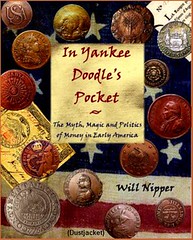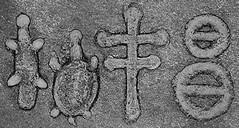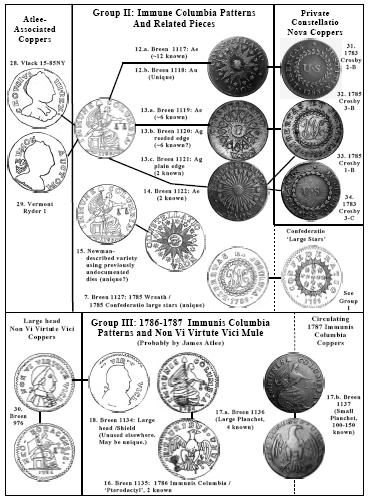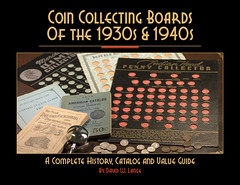
PREV ARTICLE
NEXT ARTICLE
FULL ISSUE
PREV FULL ISSUE
V11 2008 INDEX
E-SYLUM ARCHIVE
BOOK REVIEW: IN YANKEE DOODLE.S POCKET BY WILL NIPPER
 Last week Tom Kays submitted a review of Will
Nipper's new book; this week it's my turn. Many thanks to Will who
provided copies of the text and images reproduced here.
Last week Tom Kays submitted a review of Will
Nipper's new book; this week it's my turn. Many thanks to Will who
provided copies of the text and images reproduced here.It was a delight to open the package which arrived in the mail this week with a copy of In Yankee Doodles Pocket . The Myth, Magic and Politics of Money in Early America. It's a beautiful and welcoming 568-page hardcover work with a glossy color dust jacket. The blue cloth cover and spine are lettered in a shiny copper color, along with an image of the deer from the Higley copper. As Tom noted, it's a lavish work that I'll make room for on my shelf. A lesser work will have to go.
We bibliophiles all know the first question visitors ask when first encountering our libraries: "Did you read all of these books?" For most of us, the honest answer is "No" (if not, "Hell, No!"). As much as I love having quick access to my books for reference, only a select few are page turners to be read from beginning to end. Will's book joins that elite club in my eyes.
Like classics such as Neil Carothers' Fractional Money and Willem's The United States Trade Dollar, I think this book is one numismatists will want to enjoy from cover to cover. Here it is, all in one volume - the complete sweep of American numismatic history from barter through the early Federal issues. If I were Library Czar, a copy would be placed in every high school, college and university library in the country.
The opening paragraphs of the book's preface properly set the stage.
Yankee Doodle didn't really have a pocket, at least not
the kind we know. He probably just kept a cloth or leather bag tied inside
his coat. Just as we do with the paper dollars and copper-clad cents that
we put in them, built-in pockets are another convenience third-millennium
Americans take for granted.
It was not always so. As inevitable as America's success seems to have been, the fact remains that most of our early history was spent a false step from disaster. Though it happened very quickly by history's standards, transforming a motley collection of European outposts into a wealthy and powerful young nation was quite an ordeal.
The monies of pre-1840 America were both witnesses to this remarkable change and vital instruments of it. They tell of imperial and personal triumph . and folly. They celebrate our remarkable capacity for invention and adaptation. More importantly, they speak of the great American struggle between diversity and unanimity that was and remains a defining national principle. As we evolved from pluribus to something approaching unum, so did our money.
It was not always so. As inevitable as America's success seems to have been, the fact remains that most of our early history was spent a false step from disaster. Though it happened very quickly by history's standards, transforming a motley collection of European outposts into a wealthy and powerful young nation was quite an ordeal.
The monies of pre-1840 America were both witnesses to this remarkable change and vital instruments of it. They tell of imperial and personal triumph . and folly. They celebrate our remarkable capacity for invention and adaptation. More importantly, they speak of the great American struggle between diversity and unanimity that was and remains a defining national principle. As we evolved from pluribus to something approaching unum, so did our money.
 From p36: a soapstone trade silver mold with
reservoirs for (left to right) a beaver, a turtle, a Cross of Lorraine,
and two sizes of buckles... This inch-thick mold was found near the
intersection of the Wabash river and the Ohio/Indiana border.
From p36: a soapstone trade silver mold with
reservoirs for (left to right) a beaver, a turtle, a Cross of Lorraine,
and two sizes of buckles... This inch-thick mold was found near the
intersection of the Wabash river and the Ohio/Indiana border.
From the first chapter:
Early Americans were separated widely by geography,
history, language and a host of other barriers, but they shared one
unifying concept: The inevitable human tendency to trade. Trade occurred
spontaneously in the wilderness, at street front shops, in smoky taverns
and on waterfront piers. It reached down to the Caribbean, across the
Atlantic and all the way to the Orient. In time, England tried to control
nearly every official aspect of American trade.
Even a king, however, cannot watch everyone, especially when his colonies are remote and immersed in a complex socio-political landscape. When the Pilgrims arrived in Massachusetts, for example, the Spanish already had occupied Florida for over half a century and the nearby West Indies for even longer. French Huguenots had attempted settlement in what are now the Carolinas. Coureurs de bois (.runners of the forest.) were roaming France's wilderness empire and the Dutch would soon have a foothold in what is now New York, incorporating in 1655 a 1638 settlement of Swedes and Finns.
It would not be long until African traditions and slave trade economics found their way to America. Then there were the Native American populations. Each group coveted things that the others possessed. Only law and lack of currency stood between these groups and trade. Both constraints proved weak deterrents, however, as colonists circumvented the former and adapted or invented the latter. These were early signs of American independence.
Even a king, however, cannot watch everyone, especially when his colonies are remote and immersed in a complex socio-political landscape. When the Pilgrims arrived in Massachusetts, for example, the Spanish already had occupied Florida for over half a century and the nearby West Indies for even longer. French Huguenots had attempted settlement in what are now the Carolinas. Coureurs de bois (.runners of the forest.) were roaming France's wilderness empire and the Dutch would soon have a foothold in what is now New York, incorporating in 1655 a 1638 settlement of Swedes and Finns.
It would not be long until African traditions and slave trade economics found their way to America. Then there were the Native American populations. Each group coveted things that the others possessed. Only law and lack of currency stood between these groups and trade. Both constraints proved weak deterrents, however, as colonists circumvented the former and adapted or invented the latter. These were early signs of American independence.
The book's long-view historical perspective reminds me of an author I mentioned last week, John Steele Gordon, whose 2005 Empire of Wealth: The Epic History of American Economic Power is one of my favorite non-numismatic books.
For an idea of the book's broad coverage, look no farther than the table of contents. There are twelve chapters in four sections. Here are the topics covering in just sections three and four, spanning pages 79 through 232:
Section III: The Incidentals (1550 to 1820)
5: Britannics Realm
Regal, Commonwealth and Patent Coinages
Contemporary Counterfeits and the British Evasion
Island Coins and Tokens
Privately Issued Tokens
6: Spain and Her New World Colonies
The Earliest New World Coinage
The Age of Cobs
Pistareens and Other Domestic New Plate Coinage
Colonial Milled Coinage
7: The Chorus
The Netherlands
France
Portugal and Brazil
Tools of the Trade
Section IV: Early American Coins and Tokens (1616 to 1840)
8: Colonization (1616 to 1763)
A Rude Beginning: Sommer Islands Coinage (Ca. 1616)
Massachusetts Silver Coinage (1652 to 1682)
Maryland's Lord Baltimore Coinage (Ca. 1659)
St. Patrick or Mark Newby Coppers (Ca. 1667 to 1672)
American Plantations Tokens (1688)
Elephant Tokens (Ca. 1694)
French Issues Used in Louisiana and Canada (1640 to 1764)
Oddfellows: Miscellaneous Early Tokens (Ca. 1665 to 1715)
William Wood's Coinages (1722 to 1724, 1727 and 1733)
Value Me as You Please: Dr. Higley's Copper Threepence (1737 to 1739)
Hibernia Voce Populi Tokens (1760)
Attesting to the author's thoroughness is this illustration of the Bar Copper showing the coin together with actual examples of the colonialera buttons the design was modeled after. I've read about the coin's connection to button designs, but don't recall ever seeing such buttons illustrated.

One numismatic item discussed in the book that I hadn't encountered before is the Ferryland, Newfoundland "DK" token, perhaps the first such token made in North America.
These lead tokens were excavated by archaeologists at
Ferryland, a seventeenth century fishing village. Dr. Louis Jordan
described them in a presentation to the annual convention of the Colonial
Coin Collectors Club (C4) in 2006
For this purpose, Kirke ran a .common tavern. in his own house. It seems likely that the lead tokens were used as small change in the tavern. Based on the sizes of the recovered pieces, units of one, two and three were used, though just what the unit was is in question. The .DK tokens. differ from most Elizabethan lead tokens in that they are struck rather than cast. Based on research done by Ray Williams and presented at the 2006 C4 convention, it appears that the weights of the tokens correspond to musket balls of known calibers. Since musket balls were accepted in their most useful (spherical) form as half-farthings, the reason for pounding them flat and stamping them with David Kirke's monogram is a mystery
For this purpose, Kirke ran a .common tavern. in his own house. It seems likely that the lead tokens were used as small change in the tavern. Based on the sizes of the recovered pieces, units of one, two and three were used, though just what the unit was is in question. The .DK tokens. differ from most Elizabethan lead tokens in that they are struck rather than cast. Based on research done by Ray Williams and presented at the 2006 C4 convention, it appears that the weights of the tokens correspond to musket balls of known calibers. Since musket balls were accepted in their most useful (spherical) form as half-farthings, the reason for pounding them flat and stamping them with David Kirke's monogram is a mystery
The book also carefully illustrates important coin design elements. Here is just ONE of the line drawings illuminating the description of New Jersey cent designs:

Another important feature that I really appreciated seeing were the charts showing the linkage of various designs across coin types, such as this chart showing the linkage between the Immunis Columboia and Constellatio Nova coinage:

For more information on the publisher's web site, see: In Yankee Doodle's Pocket (http://www.bowmanstonepress.com/index_files/detailspage.htm)
The book is well annotated with (count 'em) 1,014 endnotes and seventeen pages of references to works in print, conversations and correspondence (public and private), and online and other works.
If I can sum up my review in one word, it would be this: WOW!.
Author Will Nipper adds:
I've set up a 25% discount code on the website. Your
readers can take advantage of the discount by entering "esylumreader" in
the shopping cart's special offer code.
| 'Extraordinary Merit' NLG Award Winner Coin Collecting Boards of the 1930s & 1940s: A Complete History, Catalog & Value Guide. $39.95 plus $5 shipping Buy directly from the author and get your copy signed. I also sell my several other books. POB 20892 Bradenton, FL 34204 |  Visit my website: |
Wayne Homren, Editor
The Numismatic Bibliomania Society is a non-profit organization promoting numismatic literature. See our web site at coinbooks.org.
To submit items for publication in The E-Sylum, write to the Editor at this address: whomren@gmail.com
To subscribe go to: https://my.binhost.com/lists/listinfo/esylum
All Rights Reserved.
NBS Home Page
Contact the NBS webmaster
